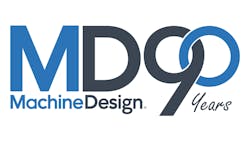As part of Machine Design’s 90th anniversary issue in January, we’ve asked industry experts to take a look at the present and future of technology and how it will impact the design and operation of manufacturing over the next decade.
Q: Before we look ahead, let’s look back at the last 10 years. There has been so much change, but what would you cite as one or two significant changes in the previous decade?
Hemmelgarn: A decade ago, we were only scratching the surface of what we consider normal and commonplace in machine engineering and manufacturing. One significant development is the core technologies around embedding simulation into the design process. We are democratizing the foundational simulation technologies allowed for engineers to refine the design without leaving the design environment. At the same time, the technologies enabling multi-discipline simulation and optimization through iteration have been groundbreaking in assisting engineers to solve increasingly complex machine design challenges. It has fueled the development in generative design and additive manufacturing, which will become commonplace in machine design in the next decade.
Q: What’s the one technology update that every design engineer should be incorporating into their systems today? What’s the one technology upgrade that every end-user should be demanding?
Hemmelgarn: Machines have nearly always been a combination of mixed domains—mechanical, fluids, electrical, and software. This scenario seems to be accelerating, as machine designers need to find more creative ways to build faster, more reliable machines. Specialized domain expertise and, especially, software that was fit to the purpose of each domain, is an inhibitor to collaboration and a more agile approach to machine development.
Machine builders that are not taking into consideration a more inclusive approach miss a huge opportunity to create more innovative and differentiated machines. This builds the disruption in the industry. Consider the ability to create a complete, multi-domain digital version of the machine and simulate not only the reaction forces of a single-use case, but the entire machine operation cycle, validating the PLC code along the way.
Hemmelgarn: Machine designers have been using IIoT and smart sensor technology as a way of monitoring the machine operation, but the future belongs to companies that can use that same technology to influence the actual machine operation. The adaptable machine is one that has enough information to be able to adjust its performance.
A brief example would be a machine tool programmed to optimize speed and feed rates based on understanding the workpiece properties and machine loading. CAM programs specify the spindle speed and feed rates based on the materials known to the programmer. We have made some significant advancements in CAM technology to eliminate waste through adaptive milling in our software, so that helps the upfront CAM design. But what if the machine tool had sensors to validate the metrology of the part and could adapt the code based on specific inputs from sensors to maximize the quality and minimize production time?
Fundamentally, those kinds of changes will also enable economic model variations in the way machinery companies interact with their machines over service life. Having the ability to collect operating data, and even code optimization to push continuous improvements to machines in the field will open new business models for companies to provide production-as-a-service. This will provide increased revenue over time than the build-and-replace business model.
Then the sensors provide feedback on machine health with a richer set of information, having the ability to adjust performance while simultaneously requesting a specific type of service, such as a bearing replacement.
Moreover, Siemens provides a closed-loop process to the digital twin of either the product being built or the production planning. Therefore, the customer can make informed decisions in confidence, given the ability to validate or modify it virtually.
Q: What does manufacturing look like in 10 years? And what are some of the broad areas your company is focusing on to bring about those changes?
Hemmelgarn: Manufacturing is experiencing a renaissance, based on socio-economic circumstances and rapid advancements in technology and user experience. Typically, manufacturing is more conservative in adopting new technology, but the aging of the workforce and the seismic shift in technology adoption by those entering that workforce are forcing more rapid changes.
The shortage of workers, greater complexity in all our products, and the greater availability of digital information about the machine in production will radically change manufacturing in the next decade. Manufacturing employees are already seeing how a more intimate user experience will benefit the company and make their work more rewarding and involved.
Collaborative robots are only the beginning in this trend. More autonomous machines that adapt to rapid changes in production requirements will be more common, along with factories becoming more flexible—a necessity due to the mass customization we see in all aspects of our lives. The old ways of thinking about fixed production units and even current efforts in lean manufacturing will seem quaint in the next 10 years.
About the Author

Bob Vavra
Editor Emeritus, Machine Design and Power & Motion
Bob Vavra is the former senior content director of Machine Design and Power & Motion.

